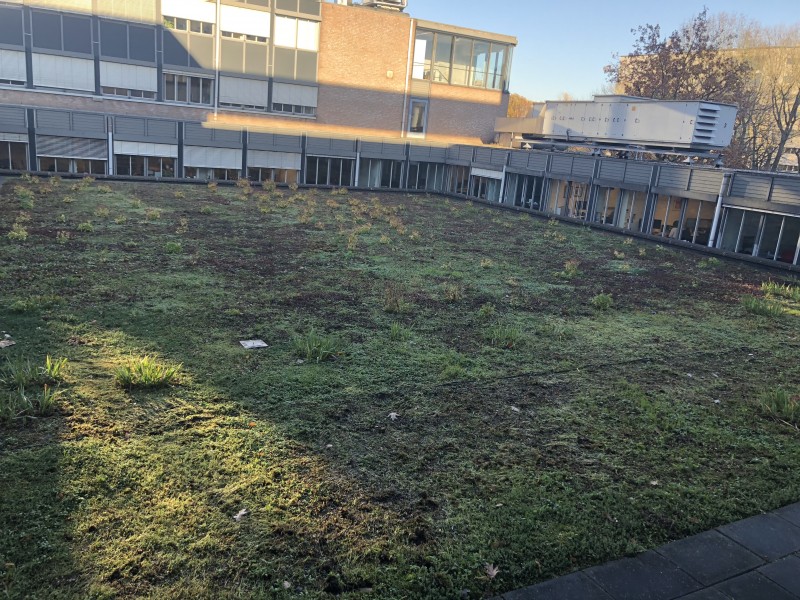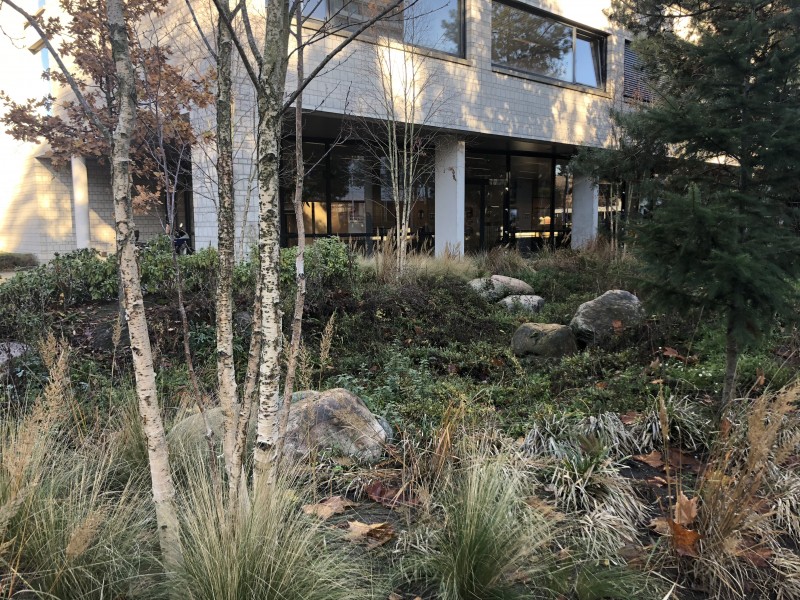Tilburg University: a climate-proof campus
Tilburg University is expending a great deal of effort on collecting rainwater on its campus. For example, the university has constructed green roofs on five different buildings in addition to a rainwater infiltration wadi. Rainwater from the brand-new CUBE building is being infiltrated into the soil one hundred percent. And finally, rainwater from the sports centre is collected in a 36,000 litre underground reservoir to be used for flushing toilets.

Image: green roof on Tilburg University (photo: Marieke de Kort)
Results
Green roofs
Five campus buildings have been fitted with green roofs, totalling a surface area of some 4,500 square metres. A large section of this surface area has been planted with sedum (succulents), but Tilburg University is also using herbs as roof vegetation on roofs whose solar orientation is less suitable for sedum. The green roofs offer many advantages for the campus: they have a cooling effect, they serve as short-term peak water storage facilities, and they slow down rainwater during downpours. In addition, they enhance the appearance of the buildings, while boosting air quality and biodiversity.
Rainwater collection in a wadi
Located centrally on the campus is a green biotope, a wadi, which collects rainwater from the roof of the Warande building. This rainwater is infiltrated into the soil. In addition to water from the roof, rainwater from an adjoining terrace and the campus main street is collected in seven wells and infiltrated into the wadi. The wadi serves as a natural connection between the nearby Warande woods, the campus, and the city. With this biotope, Tilburg University also aims to beautify its campus and foster biodiversity. The wadi serves as a habitat for several insect and small amphibian species.
 Image: wadi at Tilburg University (photo: Marieke de Kort)
Image: wadi at Tilburg University (photo: Marieke de Kort)
Rainwater down the toilet
The university Sports Centre collects 36,000 litres of rainwater in an underground reservoir. This rainwater is used to flush the toilets in the sports centre. A full tank is sufficient for some 6,000 flushes.
Climate-proof new CUBE building
The CUBE building has earned the BREEAM sustainable construction hallmark with four (out of five) stars. One of the hallmark components addresses climate adaptation. For example, the design of the building and the surrounding premises has factored in extreme rainfall. All the rainwater from the CUBE roof is infiltrated into the soil through a hollow crate system. Furthermore, the surrounding premises have been planted with species that are quite capable of surviving on natural rainfall and do not need additional watering, not even in times of severe drought.
Lessons to be learned
According to Tilburg University, it is important to conduct ecological research in the early stages of new construction plans. This is because the university is not just focusing on climate adaptation on its campus, but aims to address the entire eco system: how can nature be involved in existing construction plans? During the construction process, choices need to be made regarding rainwater drainage or run-off, and regarding the vegetation to be planted.
Another lesson to be learned pertains to planning. In the past, sustainability measures on the campus usually involved ad hoc efforts. Currently, policy plans have been developed to underpin choices.
This is how Tilburg University is working on sustainability and climate adaptation.
Contact person
Marieke de Kort
Program Manager Sustainability Tilburg University
M.dekort@tilburguniversity.edu
